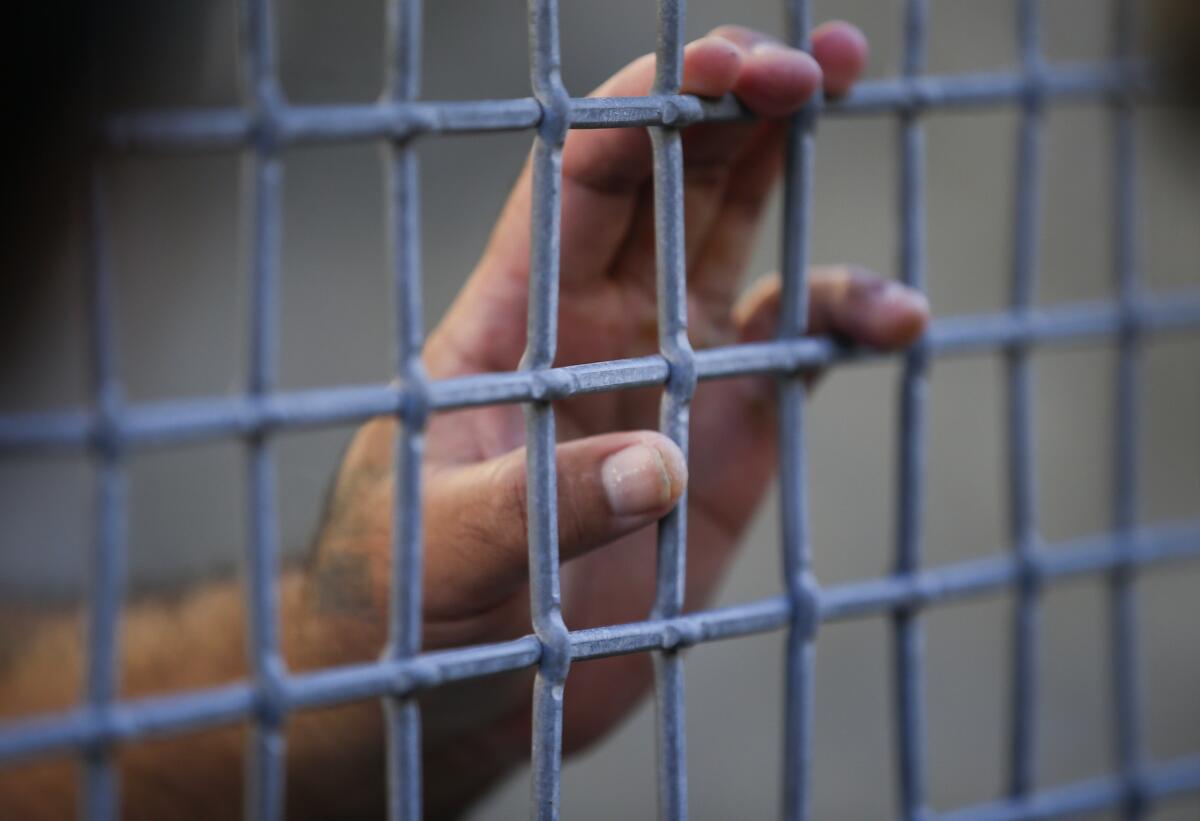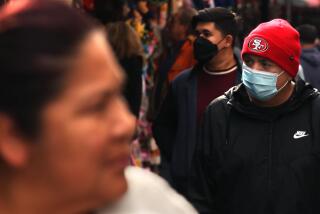San Quentinâs coronavirus outbreak shows why âherd immunityâ could mean disaster

SAN FRANCISCO â For critics of aggressive stay-at-home orders, the solution seems clear: Reopen the economy and enough people will eventually become infected by the novel coronavirus to achieve âherd immunityâ even before a vaccine is available.
The idea is that eventually, a sufficient percentage of the population will have survived COVID-19 and become immune, which in turn protects the rest of the uninfected population by interrupting the spread of the virus.
But the disastrous situation unfolding at San Quentin State Prison over the last two months has become the latest of several cautionary tales that show how any effort to achieve herd immunity before a vaccine is available would come with enormous costs in terms of illness and death.
COVID-19 spread unchecked across Californiaâs oldest prison in ways that stunned public health experts, despite efforts to control the disease. As of Monday, there had been more than 2,200 cases and 25 deaths, among a population of more than 3,260 people. On Sunday, a guard became one of the latest to die.
That means more than two-thirds of the prisonâs population has been infected, said Dr. George Rutherford, epidemiologist and infectious diseases expert at UC San Francisco.
And though new cases have slowed, they are still occurring â with 60 reported in the last two weeks â suggesting herd immunity has not yet been achieved.
San Quentinâs death toll translates to a mortality rate of about 767 people dying out of every 100,000 persons.
If that same rate occurred across California, that would translate to a staggering 300,000 deaths statewide â many times larger than Californiaâs cumulative death toll of more than 10,400. Nationally, that would be equivalent to 2.5 million deaths; the current cumulative U.S. death toll is more than 163,000.
âYou couldnât help but get it â youâre staying in a place with no ventilation,â Michael Kirkpatrick, 62, told The Times a week after he was freed. Kirkpatrick was released from San Quentin on July 13 after his parole on a burglary conviction was expedited because of the outbreak. He tested positive for the virus and has since recovered.
Kirkpatrick said his cellmate was infected, along with most of the rest of the inmates in the 50 or so cells on his tier.
âThey put a little white piece of paper on the door of everyone who was positive,â Kirkpatrick said. âOn our wing, there were, like, maybe five cells that didnât have that piece of paper on them.â
San Quentin is an imperfect setting to help understand when herd immunity might be achieved. Prisons are crowded settings that will promote coronavirus transmission more so than among people in other settings, like those who live in single-family homes.
But the San Quentin experience â as well as other data â does show that, in the absence of a vaccine, âin order to get to something that approaches herd immunity, weâre going to have to get something well on the far side of 50% of people infected,â Rutherford said. âWhich comes with a resultant large cost in mortality and severe morbidity.
âIf you believe the San Quentin stuff, you got to get up to way-up-there before you start seeing slowing of transmission,â Rutherford said.
Dr. Anthony Fauci, the U.S. governmentâs top infectious diseases expert, last week guessed it will probably require 50% to 75% of a population to be immune before achieving herd immunity â a goal that should be achieved not just through infected people recovering but also through vaccination.
California has a long way to go before the vast majority of residents have been infected.
In May, only about 2% of L.A. County residents had test results indicating presence of the antibodies to the coronavirus, indicating previous exposure to the virus. That means 98% of L.A. Countyâs residents as of late spring were still susceptible to infection.
The prevalence of past coronavirus infection in the Bay Area was even less, with just 1% having evidence of it in late April, according to the U.S. Centers for Disease Control and Prevention.
Sweden famously pursued a herd immunity strategy when it decided not to impose a severe lockdown.
But now, Sweden has among the highest mortality rates among European countries, and has a worse rate than that of the United States.
Sweden has reported 5,763 deaths â a mortality rate of 57 deaths for every 100,000 residents, according to Johns Hopkins University. The United States is reporting a mortality rate of 50 deaths for every 100,000 residents.
Swedenâs neighbors, by contrast, report far fewer deaths. Denmark has a mortality rate of 11 deaths per 100,000 residents; Norwayâs is five deaths per 100,000 residents.
And Sweden appears to be nowhere near herd immunity, with only 7% of the population testing positive for antibodies to the coronavirus, âleaving them far from reaching natural herd immunity in the population,â according to a commentary by two virologists in Switzerland, published in the journal Lancet. âMost of the population appears to have remained unexposed to [the coronavirus], even in areas with widespread virus circulation.
âIn light of these findings, any proposed approach to achieve herd immunity through natural infection is not only highly unethical, but also unachievable,â the commentary said, written by Isabella Eckerle and Benjamin Meyer.
The CDC estimates that perhaps only 23% of New York Cityâs population has had past infection with the coronavirus. New York City could easily fall into a second wave of severe coronavirus pandemic conditions, Rutherford said.
Other data show how itâs possible for far larger proportions of the population to get infected.
Among three slums in Mumbai, India, 57% of people tested have been exposed to the coronavirus, according to the BBC, citing a survey conducted by government officials. On a cruise ship with 217 passengers that left Argentina in March bound for Antartica, 59% tested positive for the virus, according to a study published in the journal Thorax.
Even nations that have previously been seen as hard hit still have plenty of susceptible people to fuel a second wave of disease.
Spain was hard hit in its first surge of the pandemic, having an experience as bad as Italy and New York City, Rutherford said. But a study in the journal Lancet said only about 5% of the population had antibody test results indicating past exposure to the virus.
Recently, Spain began experiencing a second wave of cases.
What all of this means is that a vaccine is going to be essential to controlling the pandemic.
Though officials and experts are expressing cautious optimism that California as a whole appears to be heading out of the current surge of disease, they are already warning the public to expect new surges of cases in the coming months â perhaps when disease levels fall low enough that more schools can begin to reopen.
Gov. Gavin Newsom last week said heâs anticipating a new wave of disease in the fall â and is hoping that coronavirus disease transmission falls before the flu season hits. Newsomâs Health and Human Services Agency secretary, Dr. Mark Ghaly, also spoke last week about second and third waves of disease.
In the last global pandemic comparable to this one, in 1918-19, there were three distinct waves of flu in the U.S., with levels of disease falling back down to the baseline level after the first wave hit.
But Rutherford warned that itâs possible that California may be unable to get its disease down to a similar baseline level, given how the disease is extraordinarily widespread.
âI think itâs almost impossible for us to return to baseline given how many people are infected and how broadly distributed the infection is,â Rutherford said. âSo weâll see it go ... down a little bit before it starts to go back up again,â rising whenever officials think itâs OK to allow adolescents to return to school.
âThis is not going to be controlled without vaccine. Make no mistake about it,â Rutherford said. âThe solution is immunization.â
Fauci, at a forum Wednesday hosted by the Harvard T.H. Chan School of Public Health, said he thinks officials will know by the end of this year or the beginning of next year, based on initial data from early studies, âwhether we have a safe and effective vaccine. Iâm cautiously optimistic that we will be successful.â
Fauciâs optimistic timeline is based on the assumption that everything will go right, said Dr. Joel Ernst, chief of UC San Franciscoâs division of experimental medicine.
But itâs also plausible that we might not get an answer about a safe and effective vaccine until 2022, Ernst said, citing a more pessimistic timeframe offered by the scientists who designed the clinical trials for the vaccine. âThatâs very conservative,â he said.
âItâs difficult to predict exactly what date things will be ready,â Ernst said.
It will also take time to figure out a way to start immunizing Americans. There wonât be enough vaccines to inoculate everyone in the nation immediately. âThere will be a period of time when vaccines are proven to be safe and effective that youâre not going to have 300 million doses right away. So youâre gonna have to prioritize who gets it first,â Fauci said.
In contrast to President Trump saying the coronavirus will simply âgo away,â some officials in California are bracing the public to face the reality that the coronavirus will be with us for the foreseeable future.
We need to get âeveryone in shifting their mind-set to a long game,â said Santa Clara County health officer Dr. Sara Cody. âWe have to be changing our behavior for a very, very long time.â
âIf we see that the cases are rising and theyâre rising fast, then we may need to put more stricter controls into place, as we did back in March,â Cody said.
Dr. Christina Ghaly, L.A. Countyâs director of health services, said the virus is just as capable of spreading now as it was several weeks ago. âAnd it will continue to spread if we give it a chance to do so.â
Lin reported from San Francisco, Christensen from Southern California.
More to Read
Sign up for Essential California
The most important California stories and recommendations in your inbox every morning.
You may occasionally receive promotional content from the Los Angeles Times.












